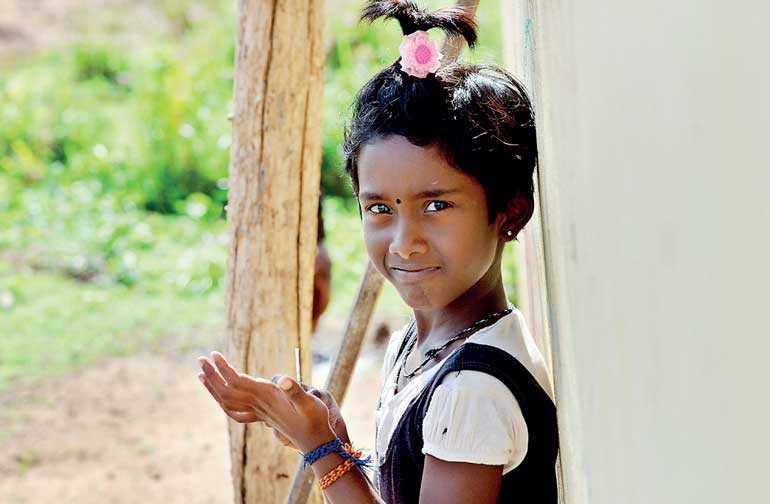Thursday Feb 13, 2025
Thursday Feb 13, 2025
Friday, 26 October 2018 00:00 - - {{hitsCtrl.values.hits}}

The HCI shows that Sri Lanka performs well in the child survival index. Accordingly, a child born today has a 99% chance of surviving to age five. Further, both girls and boys have the same chance of surviving to age five. But, Sri Lanka’s performance in all other components of human capital leaves much to be desired – Pic by Shehan Gunasekara
 By Nisha Arunatilake
By Nisha Arunatilake
The World Bank has launched its Human Capital Project (HCP) intended to improve the human capital of people. Through this, it aims to facilitate equity and economic growth. The project rightly recognises that, to be productive, people need to improve their skills, health, knowledge, and resilience.
The project has three main components. The first is an index to measure the human capital of people (i.e., The Human Capital Index). The other two are initiatives to improve the measurements and research on human capital. Countries are expected to boost their human capital, based on the findings of research.
The Human Capital Index (HCI) summarises the ‘amount of human capital a child born today could expect to attain by age 18’. Sri Lanka’s HCI for 2018, the best in the South Asian region, is 0.58. However, a score of 0.58 indicates that Sri Lanka’s performance is 42% less than its potential.
Climbing up in this index can enhance both economic productivity and economic growth. As such, rather than being pleased about its achievements in the HCI relative to that of other countries in South Asia, Sri Lanka needs to ask how it can improve its human capital potential. A closer examination of the sub-indices of the HCI shows areas that need attention.
The HCI shows that Sri Lanka performs well in the child survival index. Accordingly, a child born today has a 99% chance of surviving to age five. Further, both girls and boys have the same chance of surviving to age five. But, Sri Lanka’s performance in all other components of human capital leaves much to be desired.
Education indicators
One area where Sri Lanka is doing poorly is in quality-adjusted years of schooling. According to the HCP, the expected number of years of schooling for a child born in Sri Lanka today is 13 years. This is not too bad, as the international best practices expect children to have 14 years good quality schooling by age 18 years.
But the HCP does not only look at years of schooling. It also includes a measure of quality of schooling, based on harmonised test scores, which can range from 325 to 600. Sri Lanka’s harmonised test score of 400 is at the lower end of the spectrum. As a result, after adjusting for learning, the years of schooling index in Sri Lanka drops to 8.3 years, indicating that nearly five years of the 13 years of schooling does not result in additional learning.
According to the Ministry of Education (MoE), close to half the students fail the G. C. E. Ordinary Level (O-Level) exam, mainly due to failing mathematics. A recent IPS study revealed the need to improve the training of teachers and principals, and streamline recruitments so that subject qualifications are taken into account when allocating teachers to schools.
Health indicators
 The HCI comprises of two health indicators. The first is a measure of nutrition adequacy of children. It is measured by the fraction of children under-five who are not stunted. According to data, only 83% of under-five year olds in the country are not stunted.
The HCI comprises of two health indicators. The first is a measure of nutrition adequacy of children. It is measured by the fraction of children under-five who are not stunted. According to data, only 83% of under-five year olds in the country are not stunted.
The Sri Lanka Human Development Report 2012, compiled by IPS, showed that poor nutrition accounts for 30% of multidimensional poverty in the country. Although the country has initiated several programmes in this regard, the nutrition levels of under-five year olds have improved only marginally. For example, research highlights that from 2006 to 2016 the percentage of underweight children in the country has reduced by less than one percentage point, from 21.1% to 20.5%.
The second health indicator measures the survival rate of adults. It is captured by the probability of a 15 year old surviving till age 60. According to the HCP, the overall adult survival rate for Sri Lanka is 0.87 – indicating that Sri Lanka has achieved 87% of its potential for adult survival. The rate itself is satisfactory, considering the world average for adult survival is 85%. But what is of concern is the gender disparity in this index.
While the adult survival rate for girls is 93% in Sri Lanka, the adult survival rate for boys is only 81%. This indicates a 12 percentage point gap in the survival rates of 15 year old girls and boys. Moreover, the adult survival rate for boys is less than the world average. More studies need to be conducted to ascertain the reasons for poor survival of boys.
The World Bank’s Human Development Project should be commended for several reasons. First, the HCI is an improvement from the earlier indices, as it also pays attention to quality aspects. Also, the project recognises that any measure of human capital needs to be continuously reviewed and revised to match the needs and demands of a changing world. Lastly, it aims to use the results of HCI and its sub-components to prioritise interventions for enhancing human capital.
(Nisha Arunatilake is the Director of Research at the Institute of Policy Studies of Sri Lanka (IPS). To talk to the author, email [email protected]. To view this article online and to share your comments, visit the IPS Blog ‘Talking Economics’ – http://www.ips.lk/talkingeconomics/)
Discover Kapruka, the leading online shopping platform in Sri Lanka, where you can conveniently send Gifts and Flowers to your loved ones for any event including Valentine ’s Day. Explore a wide range of popular Shopping Categories on Kapruka, including Toys, Groceries, Electronics, Birthday Cakes, Fruits, Chocolates, Flower Bouquets, Clothing, Watches, Lingerie, Gift Sets and Jewellery. Also if you’re interested in selling with Kapruka, Partner Central by Kapruka is the best solution to start with. Moreover, through Kapruka Global Shop, you can also enjoy the convenience of purchasing products from renowned platforms like Amazon and eBay and have them delivered to Sri Lanka.
Discover Kapruka, the leading online shopping platform in Sri Lanka, where you can conveniently send Gifts and Flowers to your loved ones for any event including Valentine ’s Day. Explore a wide range of popular Shopping Categories on Kapruka, including Toys, Groceries, Electronics, Birthday Cakes, Fruits, Chocolates, Flower Bouquets, Clothing, Watches, Lingerie, Gift Sets and Jewellery. Also if you’re interested in selling with Kapruka, Partner Central by Kapruka is the best solution to start with. Moreover, through Kapruka Global Shop, you can also enjoy the convenience of purchasing products from renowned platforms like Amazon and eBay and have them delivered to Sri Lanka.